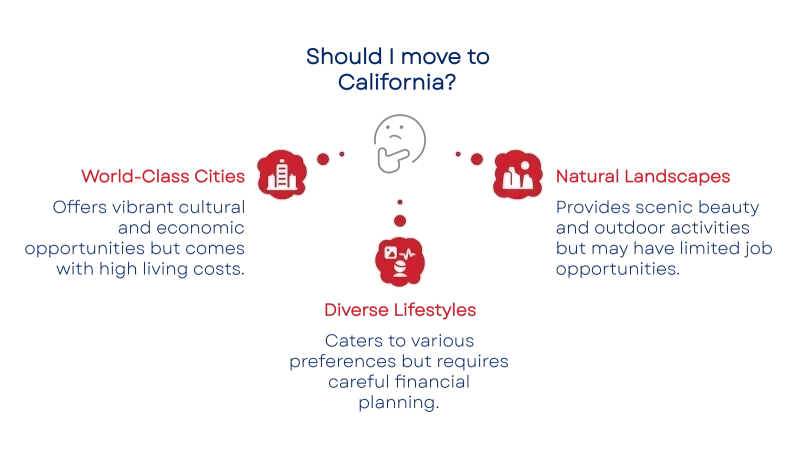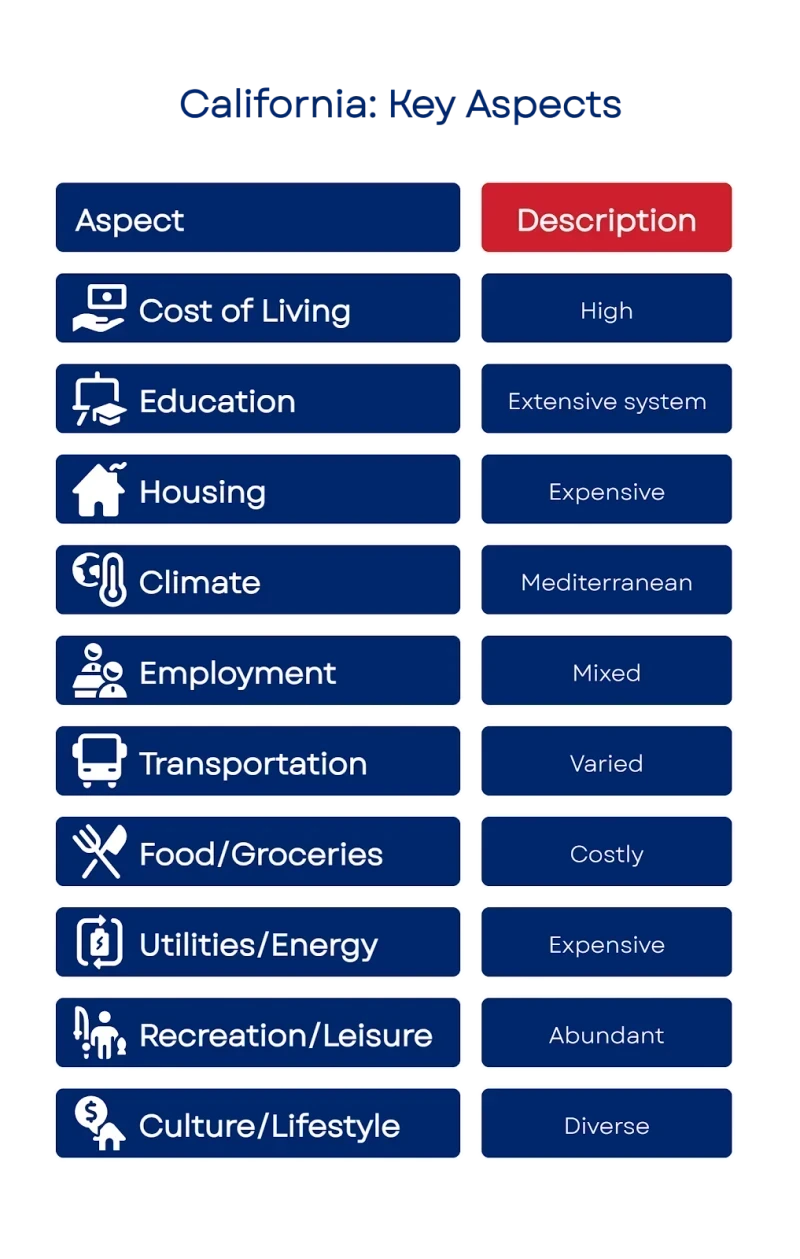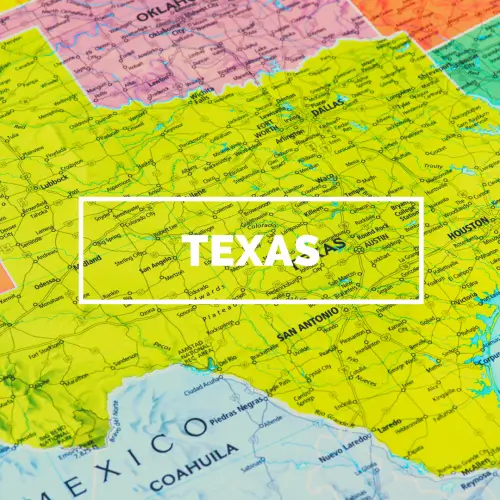California offers bustling cities, stunning natural landscapes, and a wide range of lifestyles. You can find coastal cities like Los Angeles and San Francisco, or farming areas in the Central Valley. The state offers opportunities for employment and living in many different places.
Whether you’re moving for work, education, or a change of pace, this guide outlines what to expect before making California your next home.
What You’ll Learn
This guide will walk you through:
Housing, cost of living, and utility trends across California
Employment outlook, education systems, and transportation access
Climate variation, recreation, and regional lifestyle differences
Summary
This summary outlines the key aspects of living in California, from economic factors to lifestyle, helping prospective residents make informed decisions.
California has a high cost of living, with housing costs 116% above the national average. Monthly rent averages $2,819. Groceries add to the expense, averaging nearly $298 per week. An annual income of $69,200 is recommended for individuals.
California has the most extensive education system in the U.S., with 6.2 million K-12 students and nearly 3 million higher education students. Teachers have the highest average pay at $95,160.
The median home price in California reached $884,350 in March 2025. While rental costs have cooled slightly, they remain the second-highest nationally.
California experiences a Mediterranean climate with warm, dry summers and mild, wet winters, though the climate varies significantly across regions.
California's job market has a 5.3% unemployment rate. Growing sectors include healthcare and government, while tech has declined. The state has 659,000 job openings.
Transportation options vary; major cities like Los Angeles and the Bay Area have extensive public transit, but most of California is car-dependent.
California has the highest weekly grocery expenses nationally, at nearly $298. Budget-friendly options exist at discount retailers and ethnic markets.
California has the second-highest electricity rates in the U.S. at 30.96 cents per kilowatt-hour, with average monthly bills around $240.
California offers diverse recreational opportunities year-round, including 280 state parks, beaches, mountains, and urban recreational programs.
California's culture emphasizes diversity, freedom, and a relaxed lifestyle, with a strong focus on environmental consciousness and outdoor activities.
Planning Your Move to California: What to Expect
Moving to California is an exciting decision, but it requires careful planning due to the state’s unique economic and lifestyle factors. Whether you’re relocating for a job, education, or a fresh start, understanding the cost of living in California and regional differences is crucial. From arranging California car shipping to budgeting for housing, preparation ensures a smooth transition. This section explores key steps, including researching neighborhoods, securing employment, and understanding local regulations, to help you settle into the California lifestyle with confidence.
Research neighborhoods: Use online tools to compare best places to live in California, focusing on affordability and proximity to work.
Budget for expenses: Account for high California housing market costs and utilities.
Transportation logistics: Consider California car shipping services like AmeriFreight for a hassle-free move.
Why People Are Moving to California
California’s population grew by 108,000 in 2024, reaching 39.5 million residents as of January 1, 2025.
The Golden State remains a popular destination for individuals, families, and professionals drawn by its economic diversity, climate, and lifestyle options. Despite high living costs, the state continues to attract new residents looking for personal and professional growth.
Common reasons people move to California include:
Job opportunities across multiple industries: From healthcare and public service to media and agriculture, the state supports a wide range of careers.
Mild climate and access to nature: The combination of warm coastal weather, mountain regions, and outdoor recreation makes it appealing year-round.
Diverse communities and cultural variety: California’s population includes a broad mix of backgrounds, languages, and traditions, contributing to a vibrant social environment.
For those who plan carefully and choose the right region, California offers opportunities that align with long-term goals and personal values.
Cost of Living & Housing
California is one of the most expensive states to live in. For one adult, the average cost of living is about $64,835 per year, or $5,400 per month. Families are advised to earn more than $140,000 per year.
Key data:
Housing: 116% above the national average
Rent: $2,819/month statewide; higher in cities like San Francisco and Los Angeles
Groceries: 12% above national average; $298/week per household
Utilities: Higher than average, especially electricity and water
Affordable regions: Sacramento rents are about 14% below the state average
Even though cities along the coast are expensive, some areas further inland have housing and living costs that are easier to afford. People who are careful with their money often choose suburbs or smaller cities with lower rent and shorter commutes.
Job Market & Economy
California boasts the most significant job market in the United States, driven by key sectors such as healthcare, education, government, and agriculture. In March 2025, the unemployment rate was 5.3%, which, while higher than the national average, showed signs of improvement.
Economic highlights:
Job openings: 659,000 (March 2025)
Labor force growth: +137,000 since January 2025
Expanding sectors: Healthcare (+15% since 2022), government (+6%)
Declining sectors: Tech and information (-15%), professional services (-4%)
Industry diversity: Includes entertainment, logistics, agriculture, and public administration
California's economy is strong because it has a significant global reach and a substantial local impact. Even though the tech industry has slowed down, there are more jobs in government and healthcare. There are still many job openings for people who are new to the workforce, those with special skills, and people who work in service industries in most parts of the state.
Major Cities & Communities
California has many different places to live. Big cities along the coast, like San Diego and San Francisco, have lots of cultural attractions and are easy to walk around in. Cities further inland, such as Sacramento and Fresno, have cheaper homes and are better for families.
Community snapshot:
San Francisco: High-paying jobs, dense housing, strong public transit
Sacramento: A growing metro with lower housing costs and expanding infrastructure
Los Angeles: Largest city with a wide job variety, car-heavy design
San Diego: Popular for its weather, schools, and coastal access
Central Valley: Affordable rural and suburban living, strong agricultural base
Where you live in California affects your housing choices. You can find city apartments or larger homes further inland. Suburbs and medium-sized cities often have a good mix of affordable housing and valuable services.
Education & Healthcare
California has the most extensive public school system in the U.S., with over 6.2 million students from kindergarten through 12th grade. It also has a three-part system for higher education. For residents, public universities and community colleges provide strong value.
Education facts:
K–12 districts: 944 statewide
Public college systems:
University of California (UC): 10 campuses, ~300,000 students
California State University (CSU): 23 campuses, ~500,000 students
Community Colleges: Over 1.8 million students
Teacher salaries: Highest nationwide at $95,160, average
Performance gaps: California ranks in the bottom 15 for 4th-grade reading and math
In cities, it's easy to get good healthcare at excellent hospitals like Cedars-Sinai and Stanford Health. In rural areas, people use smaller local clinics and hospitals. These places sometimes have longer waiting times or fewer doctors who specialize in specific medical areas.
Climate & Environment
California’s vast geography creates a wide range of climate zones. Places near the coast usually have mild temperatures. However, areas further away from the coast and in the mountains have bigger changes in temperature between seasons.
Climate patterns:
Coastal: Average 70°F year-round; cool summers, mild winters
Inland: Hot summers, cool winters; highs exceed 95°F in summer
Mountains: Four-season climates with snow in winter
Deserts: High heat in summer, cooler in winter
Weather risks: Wildfires, drought, and air quality issues
Long-term change: Projected 2°F rise by 2040
If you live in many parts of California, you might face wildfires, water shortages, and power outages. People in these areas often prepare by gathering emergency supplies, having solar power as a backup, and getting insurance if it's available.
Culture & Recreation
California's way of life is shaped by its diverse population, strong regional pride, and a love for outdoor activities. With 280 state parks and many public beaches, people living here can enjoy a wide range of fun and cultural experiences.
Recreation highlights:
State parks: 280+, including Yosemite, Big Sur, and Lake Tahoe
Beaches: 70 miles of public coastline for surfing, swimming, and walking
Mountains: Hiking, skiing, and camping in the Sierra Nevada
Urban attractions: Museums, music venues, food districts, arts festivals
Community events: Farmers markets, neighborhood parades, and local fairs
Cities usually help fund local parks, sports teams, and recreational classes. Bigger cities provide free events and outdoor activities all year because of California's mild weather.
Transportation
How easy it is to get around without a car in California depends on where you live. Big cities like San Francisco and Los Angeles have trains and buses. But if you live in the suburbs or the countryside, you'll need your car.
Transportation summary:
San Francisco: BART, Muni, Caltrain, ferries
Los Angeles: Metro Rail (6 lines), Metro Busway, city bus routes
San Diego: Trolley, COASTER, limited bus coverage
Regional rail: Metrolink (546 miles, eight routes across counties)
Car dependency: High outside major cities
Gas prices in California are always higher than in other parts of the country. Highways link most big cities, but traffic is often bad in Southern and Central California. How people get to work or school depends on the area and might involve using more than one type of transportation.
Food & Groceries
California spends the most on groceries in the country. However, because it grows a lot of its food, fresh fruits and vegetables are cheaper than processed foods. Shopping choices can significantly affect overall costs.
Food facts:
Average monthly grocery cost: $392 per person
Weekly average: $298 per household
Discount options: Trader Joe’s, Grocery Outlet
Premium retailers: Whole Foods, specialty markets
Ethnic markets: Offer competitive pricing and variety
People living in California can often save money by buying food at local farmers' markets or large discount stores. The cost of things can vary significantly depending on the type of store and the area.
Utilities & Energy
Utility costs in California are high due to upgrades to the state's infrastructure, its goals for using renewable energy, and expenses related to preventing and fighting wildfires.
Key details:
Electricity: 30.96¢/kWh (second-highest in U.S.); $240–$253 monthly
Natural gas: $34-$57 monthly
Water: Rising costs due to aging systems and regulation
Internet: $40-$82 monthly, depending on provider
Mitigation options: Solar panels, energy-efficient appliances, smart thermostats
You can save money on long-term costs by taking advantage of rebates and state programs that promote energy efficiency. Many new buildings are built with solar panels or are designed to meet specific energy-saving goals.
Adjusting to California’s Culture & Lifestyle
California has a rich mix of cultures and focuses on community. Its communities reflect many languages, traditions, and lifestyles. People who live there care a lot about health, protecting the environment, and being true to themselves.
Cultural notes:
Values: Environmental stewardship, inclusivity, work-life balance
Lifestyle: Casual, outdoor-oriented, and tech-influenced
Community: Social networks often form around shared activities and interests
Urban-rural divide: Varies in political views, pace of life, and public services
California is a popular place to live, with six of its cities ranking among the top 10 for overall quality of life. This is because these cities are easy to walk around in, have access to nature, and offer good job opportunities. Even though it can be expensive to live there, many people choose to stay in California for a long time because of its unique lifestyle.
Navigating the California Housing Market
The California housing market is one of the most competitive in the U.S., with median home prices at $884,350 in March 2025. For renters, the average monthly cost is $2,819, particularly high in cities like San Francisco and Los Angeles. To improve your chances in this market, start your search early and explore best places to live in California like Sacramento or Fresno, where housing is more affordable. Partnering with a local real estate agent can help you navigate bidding wars and limited inventory, ensuring you find a home that fits your budget and California lifestyle.
Median home price: $884,350, with coastal cities exceeding $1 million.
Affordable areas: Inland cities like Bakersfield offer lower rents, about 14% below the state average.
Tips for buyers: Get pre-approved for a mortgage to stand out in the competitive California housing market.
Thriving in California’s Job Market
The California job market is dynamic, with 659,000 job openings as of March 2025, particularly in healthcare and government sectors. While the unemployment rate is 5.3%, opportunities abound for skilled professionals and entry-level workers alike. Researching industry trends and networking in cities like Los Angeles or San Francisco can boost your chances of landing a job. For those moving to California, aligning your skills with growing sectors ensures long-term career success in this diverse economy.
Growing industries: Healthcare (+15% growth) and government (+6%) lead the California job market.
Networking tips: Attend industry events in major cities to connect with employers.
Remote work: Many California companies offer flexible work options, ideal for newcomers.
Embracing the California Lifestyle
The California lifestyle is a major draw, blending outdoor recreation, cultural diversity, and a relaxed vibe. With 280 state parks, public beaches, and urban attractions, residents enjoy year-round activities like hiking in Yosemite or surfing in San Diego. The state’s emphasis on environmental consciousness and inclusivity creates vibrant communities, making it easy to adapt after moving to California. Engaging in local events like farmers' markets or festivals helps newcomers integrate into this unique culture.
Outdoor activities: Access to beaches, mountains, and parks defines the California lifestyle.
Community engagement: Join local groups to build connections and embrace diversity.
Cultural hubs: Cities like Los Angeles offer museums and food scenes for all tastes.
Budgeting for the Cost of Living in California
The cost of living in California is significantly higher than the national average, with housing costs 116% above average and groceries at $298 weekly per household. To manage expenses, focus on budgeting strategies tailored to California’s high costs. Shopping at discount stores like Trader Joe’s or ethnic markets can reduce grocery bills. Additionally, leveraging energy-saving programs can lower utility costs, which average $240 monthly for electricity. Careful financial planning is essential for a successful move to California.
Grocery savings: Shop at farmers' markets for fresh, affordable produce.
Utility tips: Install solar panels or use energy-efficient appliances to cut costs.
Income needs: An annual income of $69,200 is recommended for individuals.
Streamlining Your Move with California Car Shipping
Relocating to California often involves transporting your vehicle, and California car shipping services like AmeriFreight make the process seamless. Whether you’re moving to coastal cities or inland areas, professional car shipping ensures your vehicle arrives safely and on time. Open transport is cost-effective, while enclosed transport offers extra protection for luxury vehicles. Planning your California car shipping early allows you to focus on other aspects of your move, such as securing housing or exploring the best places to live in California.
Shipping options: Choose open or enclosed transport based on your vehicle’s needs.
Cost factors: Distance, vehicle size, and transport type affect California car shipping prices.
Why AmeriFreight: Reliable, licensed carriers with flexible scheduling for your move.
Final Thoughts
California provides a variety of economic opportunities, different types of land, and many cultures that few other states can offer. Many individuals relocating from nearby states explore options like Texas to California car shipping for a smooth transition.
Moving to California offers unparalleled opportunities, from a thriving California job market to a vibrant California lifestyle. Despite the high cost of living in California, strategic planning such as choosing affordable cities, budgeting for groceries, and using California car shipping services can make your transition smoother. By understanding the California housing market and embracing the state’s diverse culture, you’ll be well-prepared to thrive in the Golden State. Start your journey by requesting a free California car shipping quote from AmeriFreight to simplify your move.
Need Help Shipping Your Car?
AmeriFreight Auto Transport offers dependable California car shipping. We offer both open and enclosed auto transport services based on your vehicle type and needs. We work directly with licensed carriers to coordinate pickup and delivery based on your schedule and route.
Request a free estimate to get started.
Frequently Asked Questions (FAQs)
What should I know about the housing market in the Bay Area before moving there?
The Bay Area continues to be one of the most expensive areas in California. Houses there often cost more than $1 million, and rent is among the highest in the state. There are not many homes for sale, and a lot of people are trying to buy them.
Are there any up-and-coming cities in California that are still relatively affordable for renters?
Cities further inland, such as Sacramento, Fresno, and Bakersfield, have more affordable homes, even though they are still in California.
How accessible are electric vehicle charging stations throughout California?
California leads the nation in the number of electric car charging stations. You'll have no trouble finding places to charge your electric vehicle on main roads, in cities, and at many workplaces.
Which parts of California have the most consistent sunny weather year-round?
Southern California cities like San Diego, Riverside, and Palm Springs get the most sun. These areas typically have over 260 sunny days annually and enjoy mild weather with minimal rainfall.
Disclaimer: The information provided in this guide is for general informational purposes only. Housing prices, job markets, and local conditions may change over time. Always research current data or consult professionals before making relocation decisions.
















